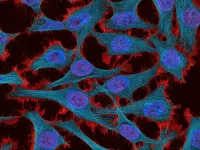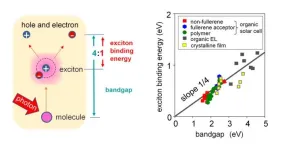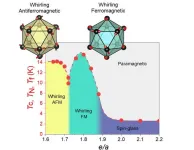Next-generation batteries could go organic, cobalt-free for long-lasting power
2024-01-18
(Press-News.org) In the switch to “greener” energy sources, the demand for rechargeable lithium-ion batteries is surging. However, their cathodes typically contain cobalt — a metal whose extraction has high environmental and societal costs. Now, researchers in ACS Central Science report evaluating an earth-abundant, carbon-based cathode material that could replace cobalt and other scarce and toxic metals without sacrificing lithium-ion battery performance.
Today, lithium-ion batteries power everything from cell phones to laptops to electric vehicles. One of the limiting factors for realizing a global shift to energy produced by renewable sources — particularly for the transition from gasoline-powered cars to electric vehicles — is the scarcity and mining difficulty of the metals, such as cobalt, nickel and magnesium, used in rechargeable battery cathode manufacturing. Previous researchers have developed cathodes from more abundant and lower cost carbon-containing materials, including organosulfur and carbonyl compounds, but those prototypes couldn’t match the energy output and stability of traditional lithium-ion batteries.
So, Mircea Dincă and his colleagues wanted to see if other carbon-based cathode materials could be more successful. They may have found a worthy candidate in bis-tetraaminobenzoquinone (TAQ). TAQ molecules form layered solid-state structures than can potentially compete with traditional cobalt-based cathode performance.
Building on their prior work that showed TAQ’s effectiveness as a supercapacitor material, Dincă’s team tested the compound in a cathode for lithium-ion batteries. To improve cycling stability and to increase TAQ adhesion to the cathode’s stainless-steel current collector, they added cellulose- and rubber-containing materials to the TAQ cathode. In the researchers’ proof-of-concept demonstration, the new composite cathode cycled safely more than 2,000 times, delivered an energy density higher than most cobalt-based cathodes and charged-discharged in as little as six minutes. The TAQ-based cathodes need additional testing before they appear on the market, but the researchers are optimistic that they could enable the high-energy, long-lasting and fast-charging batteries needed to help speed a global transition to a renewable energy future that’s cobalt- and nickel-free.
The authors acknowledge funding from Automobili Lamborghini S.p.A.
The authors have filed patent applications on this technology.
###
The American Chemical Society (ACS) is a nonprofit organization chartered by the U.S. Congress. ACS’ mission is to advance the broader chemistry enterprise and its practitioners for the benefit of Earth and all its people. The Society is a global leader in promoting excellence in science education and providing access to chemistry-related information and research through its multiple research solutions, peer-reviewed journals, scientific conferences, eBooks and weekly news periodical Chemical & Engineering News. ACS journals are among the most cited, most trusted and most read within the scientific literature; however, ACS itself does not conduct chemical research. As a leader in scientific information solutions, its CAS division partners with global innovators to accelerate breakthroughs by curating, connecting and analyzing the world’s scientific knowledge. ACS’ main offices are in Washington, D.C., and Columbus, Ohio.
To automatically receive news releases from the American Chemical Society, contact newsroom@acs.org.
Note: ACS does not conduct research but publishes and publicizes peer-reviewed scientific studies.
Follow us: Twitter | Facebook | LinkedIn | Instagram
END
ELSE PRESS RELEASES FROM THIS DATE:
2024-01-18
The College of Engineering and Computer Science of Florida Atlantic University received a $2.6 million grant from the National Science Foundation (NSF) to establish a scholarship program in the burgeoning and critical field of cybersecurity. The NSF’s CyberCorps® Scholarship for Service program seeks to increase the number of qualified cybersecurity professionals working for federal, state, local, territorial and tribal governments.
The program is managed by the NSF in collaboration with the United States Office of Personnel Management and the U.S. Department of Homeland Security. FAU is one of only six universities ...
2024-01-18
In a groundbreaking study published on January 18, 2024, in Cancer Discovery, scientists at University of California San Diego School of Medicine leveraged a machine learning algorithm to tackle one of the biggest challenges facing cancer researchers: predicting when cancer will resist chemotherapy.
All cells, including cancer cells, rely on complex molecular machinery to replicate DNA as part of normal cell division. Most chemotherapies work by disrupting this DNA replication machinery in rapidly dividing tumor ...
2024-01-18
[Boston, MA—January 18, 2023] The American Meteorological Society’s (AMS) 104th Annual Meeting will gather thousands of people at the Baltimore Convention Center 28 January–1 February to attend the world’s largest annual meeting focused on weather, water, and climate. The AMS is the professional society for everyone in the atmospheric and hydrologic sciences and services, including meteorologists, research scientists, emergency managers, academics, weather broadcasters, and more.
“The theme of our 104th Annual Meeting is ‘Living in a Changing Environment,’” says AMS President Brad Colman. “It’s ...
2024-01-18
New research has been published that identifies positive steps towards a better understanding of antimicrobial resistance (AMR), specifically in hospital-acquired pneumonia (HAP).
Antimicrobial, or antibiotic resistance, is a growing global issue, yet little is known about how to dose antibiotics to minimise bacteria developing resistance in patients. However, the University of Liverpool is playing a key role in contributing to international efforts to better understand AMR.
In a paper published today (Thursday 18 January), ...
2024-01-18
Researchers from McGill University, led by Professor Alanna Watt of the Department of Biology, have identified previously unknown changes in brain cells affected by a neurological disease. Their research, published in eLife, could pave the way to future treatments for the disease.
Spinocerebellar ataxia type 6, known as SCA6, is a rare neurological disease that disrupts the function in a part of the brain called the cerebellum, causing difficulties with movement and coordination. The condition results from genetic mutations, ...
2024-01-18
Considerable attention has focused on burnout and mental health of physicians and nurses on the frontline during the COVID-19 pandemic. First responders – law enforcement personnel, firefighters and emergency medical service (EMS) providers, also experienced increased levels of stress, anxiety and depression due to job-related pressures associated with the pandemic.
Given their exposure to work-related stress during this time, first responders may have been at considerable risk of developing problematic substance use. However, little is known about the factors associated with first responder drug and alcohol use during the pandemic.
A study by Florida ...
2024-01-18
Organic semiconductors are a class of materials that find applications in various electronic devices owing to their unique properties. One attribute that influences the optoelectronic property of these organic semiconductors is their "exciton binding energy," which is the energy needed to divide an exciton into its negative and positive constituents. Since high binding energies can have a significant impact on the functioning of optoelectronic devices, low binding energies are desirable. This can help in reducing energy losses in devices like organic solar cells. While several methods for designing organic materials with low binding energies have ...
2024-01-18
Quasicrystals are intermetallic materials that have garnered significant attention from researchers aiming to advance condensed matter physics understanding. Unlike normal crystals, in which atoms are arranged in an ordered repeating pattern, quasicrystals have non-repeating ordered patterns of atoms. Their unique structure leads to many exotic and interesting properties, which are particularly useful for practical applications in spintronics and magnetic refrigeration.
A unique quasicrystal variant, known as the Tsai-type icosahedral quasicrystal (iQC) and their cubic approximant crystals (ACs), display intriguing characteristics. These include long-range ferromagnetic (FM) ...
2024-01-18
Researchers at Karolinska Institutet in Sweden have used DNA origami, the art of folding DNA into desired structures, to show how an important cell receptor can be activated in a previously unknown way. The result opens new avenues for understanding how the Notch signalling pathway works and how it is involved in several serious diseases. The study is published in Nature Communications.
Notch is a cell receptor that is of great importance to a wide range of organisms and plays a crucial role in many different processes, including early embryonic development in both flies and humans. Notch ...
2024-01-18
The mystery behind why Alaskan horses, cryptodiran turtles and island lizards shrunk over time may have been solved in a new study.
The new theoretical research proposes that animal size over time depends on two key ecological factors: the intensity of direct competition for resources between species, and the risk of extinction from the environment.
Using computer models simulating evolution, the study, published today (Thursday, 18 January) in communications biology, identifies why some species gradually get smaller, as indicated by fossil records.
Dr Shovonlal Roy, an ecosystem modeller from the University of Reading who led the research, ...
LAST 30 PRESS RELEASES:
[Press-News.org] Next-generation batteries could go organic, cobalt-free for long-lasting power




